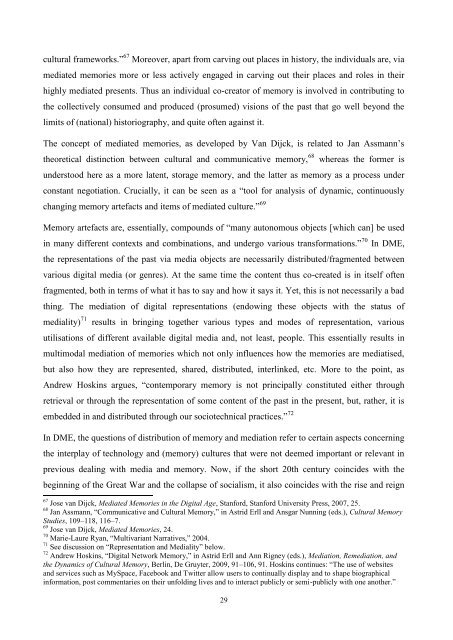UNIVERSITY OF NOVA GORICA GRADUATE SCHOOL ...
UNIVERSITY OF NOVA GORICA GRADUATE SCHOOL ...
UNIVERSITY OF NOVA GORICA GRADUATE SCHOOL ...
Create successful ePaper yourself
Turn your PDF publications into a flip-book with our unique Google optimized e-Paper software.
cultural frameworks.‖ 67 Moreover, apart from carving out places in history, the individuals are, via<br />
mediated memories more or less actively engaged in carving out their places and roles in their<br />
highly mediated presents. Thus an individual co-creator of memory is involved in contributing to<br />
the collectively consumed and produced (prosumed) visions of the past that go well beyond the<br />
limits of (national) historiography, and quite often against it.<br />
The concept of mediated memories, as developed by Van Dijck, is related to Jan Assmann‘s<br />
theoretical distinction between cultural and communicative memory, 68<br />
29<br />
whereas the former is<br />
understood here as a more latent, storage memory, and the latter as memory as a process under<br />
constant negotiation. Crucially, it can be seen as a ―tool for analysis of dynamic, continuously<br />
changing memory artefacts and items of mediated culture.‖ 69<br />
Memory artefacts are, essentially, compounds of ―many autonomous objects [which can] be used<br />
in many different contexts and combinations, and undergo various transformations.‖ 70 In DME,<br />
the representations of the past via media objects are necessarily distributed/fragmented between<br />
various digital media (or genres). At the same time the content thus co-created is in itself often<br />
fragmented, both in terms of what it has to say and how it says it. Yet, this is not necessarily a bad<br />
thing. The mediation of digital representations (endowing these objects with the status of<br />
mediality) 71<br />
results in bringing together various types and modes of representation, various<br />
utilisations of different available digital media and, not least, people. This essentially results in<br />
multimodal mediation of memories which not only influences how the memories are mediatised,<br />
but also how they are represented, shared, distributed, interlinked, etc. More to the point, as<br />
Andrew Hoskins argues, ―contemporary memory is not principally constituted either through<br />
retrieval or through the representation of some content of the past in the present, but, rather, it is<br />
embedded in and distributed through our sociotechnical practices.‖ 72<br />
In DME, the questions of distribution of memory and mediation refer to certain aspects concerning<br />
the interplay of technology and (memory) cultures that were not deemed important or relevant in<br />
previous dealing with media and memory. Now, if the short 20th century coincides with the<br />
beginning of the Great War and the collapse of socialism, it also coincides with the rise and reign<br />
67 Jose van Dijck, Mediated Memories in the Digital Age, Stanford, Stanford University Press, 2007, 25.<br />
68 Jan Assmann, ―Communicative and Cultural Memory,‖ in Astrid Erll and Ansgar Nunning (eds.), Cultural Memory<br />
Studies, 109–118, 116–7.<br />
69 Jose van Dijck, Mediated Memories, 24.<br />
70 Marie-Laure Ryan, ―Multivariant Narratives,‖ 2004.<br />
71 See discussion on ―Representation and Mediality‖ below.<br />
72 Andrew Hoskins, ―Digital Network Memory,‖ in Astrid Erll and Ann Rigney (eds.), Mediation, Remediation, and<br />
the Dynamics of Cultural Memory, Berlin, De Gruyter, 2009, 91–106, 91. Hoskins continues: ―The use of websites<br />
and services such as MySpace, Facebook and Twitter allow users to continually display and to shape biographical<br />
information, post commentaries on their unfolding lives and to interact publicly or semi-publicly with one another.‖

















